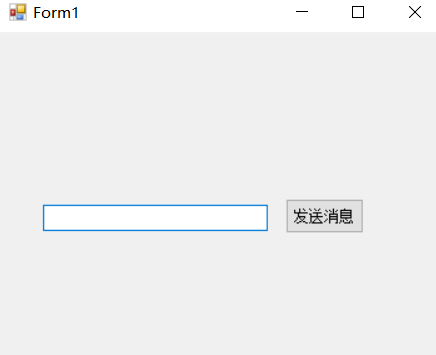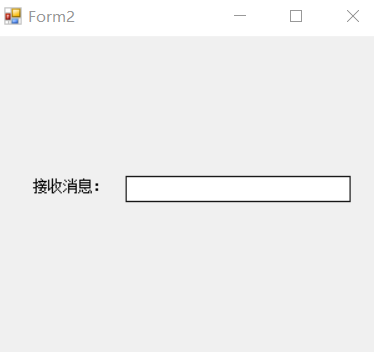您好,登錄后才能下訂單哦!
您好,登錄后才能下訂單哦!
這篇文章主要為大家展示了“C#中窗體間常用的傳值方式有哪些”,內容簡而易懂,條理清晰,希望能夠幫助大家解決疑惑,下面讓小編帶領大家一起研究并學習一下“C#中窗體間常用的傳值方式有哪些”這篇文章吧。
前言
窗體間的傳值,最好使用委托方式傳值,開始之前,我們先來說一下委托與事件的關系。
委托:是一個類。
事件:是委托類型的一個特殊實例,只能在類的內部觸發執行。
首先創建2個窗體,這里我們以form1為發送窗體,form2為接收窗體
form1窗體

form2窗體

方式一(最簡單的方式)
form1窗體代碼
using System;
using System.Collections.Generic;
using System.ComponentModel;
using System.Data;
using System.Drawing;
using System.Linq;
using System.Text;
using System.Threading.Tasks;
using System.Windows.Forms;
namespace 事件的方式實現窗體間傳值
{
public partial class Form1 : Form
{
public Form1()
{
InitializeComponent();
}
public Form2 msgFrm { get; set; }
private void Form1_Load(object sender, EventArgs e)
{
Form2 f2 = new Form2();
msgFrm = f2;
f2.Show();
}
private void btnSendMsg_Click(object sender, EventArgs e)
{
//對象內部的,字段或者元素屬性最好不要直接讓外部直接訪問
//最好是通過,設置的方法來控制一下
msgFrm.SetTxt(this.txtMsg.Text);
}
}
}form2窗體代碼
using System;
using System.Collections.Generic;
using System.ComponentModel;
using System.Data;
using System.Drawing;
using System.Linq;
using System.Text;
using System.Threading.Tasks;
using System.Windows.Forms;
namespace 事件的方式實現窗體間傳值
{
public partial class Form2 : Form
{
public Form2()
{
InitializeComponent();
}
public void SetTxt(string txt)
{
this.txtMsg.Text = txt;
}
}
}方式二(委托方式)
注:委托不熟悉的寶寶們,請自行查閱Func與Action,以及delegate三者區別,這里我們用系統內置的委托Action
form1窗體代碼
using System;
using System.Collections.Generic;
using System.ComponentModel;
using System.Data;
using System.Drawing;
using System.Linq;
using System.Text;
using System.Threading.Tasks;
using System.Windows.Forms;
namespace 事件的方式實現窗體間傳值
{
public partial class Form1 : Form
{
public Form1()
{
InitializeComponent();
}
//定義委托
public Action<string> afterMsgSend { get; set; }
private void Form1_Load(object sender, EventArgs e)
{
Form2 f2 = new Form2();
afterMsgSend += f2.SetTxt; //給系統內置的委托注冊事件
f2.Show();
}
private void btnSendMsg_Click(object sender, EventArgs e)
{
if (afterMsgSend == null)
{
return;
}
afterMsgSend(this.txtMsg.Text);
}
}
}form2窗體代碼
using System;
using System.Collections.Generic;
using System.ComponentModel;
using System.Data;
using System.Drawing;
using System.Linq;
using System.Text;
using System.Threading.Tasks;
using System.Windows.Forms;
namespace 事件的方式實現窗體間傳值
{
public partial class Form2 : Form
{
public Form2()
{
InitializeComponent();
}
public void SetTxt(string txt)
{
this.txtMsg.Text = txt;
}
}
}方式三(事件方式,更安全喲)
TextBoxMsgChangeEventArg類繼承EventArgs代碼
using System;
using System.Collections.Generic;
using System.Linq;
using System.Text;
using System.Threading.Tasks;
namespace 事件的方式實現窗體間傳值
{
public class TextBoxMsgChangeEventArg:EventArgs
{
public string Text { get; set; }
}
}form1窗體代碼
using System;
using System.Collections.Generic;
using System.ComponentModel;
using System.Data;
using System.Drawing;
using System.Linq;
using System.Text;
using System.Threading.Tasks;
using System.Windows.Forms;
namespace 事件的方式實現窗體間傳值
{
public partial class Form1 : Form
{
public Form1()
{
InitializeComponent();
}
public event EventHandler AfterMsgChange;
private void Form1_Load(object sender, EventArgs e)
{
Form2 f2 = new Form2();
AfterMsgChange += f2.AfterTxtChange;
f2.Show();
}
private void btnSendMsg_Click(object sender, EventArgs e)
{
AfterMsgChange(this, new TextBoxMsgChangeEventArg() { Text = this.txtMsg.Text });
}
}
}form2窗體
using System;
using System.Collections.Generic;
using System.ComponentModel;
using System.Data;
using System.Drawing;
using System.Linq;
using System.Text;
using System.Threading.Tasks;
using System.Windows.Forms;
namespace 事件的方式實現窗體間傳值
{
public partial class Form2 : Form
{
public Form2()
{
InitializeComponent();
}
public void AfterTxtChange(object sender,EventArgs e)
{
//拿到父窗體傳來的文本,強轉數據類型
TextBoxMsgChangeEventArg arg = e as TextBoxMsgChangeEventArg;
this.SetTxt(arg.Text);
}
}
}以上是“C#中窗體間常用的傳值方式有哪些”這篇文章的所有內容,感謝各位的閱讀!相信大家都有了一定的了解,希望分享的內容對大家有所幫助,如果還想學習更多知識,歡迎關注億速云行業資訊頻道!
免責聲明:本站發布的內容(圖片、視頻和文字)以原創、轉載和分享為主,文章觀點不代表本網站立場,如果涉及侵權請聯系站長郵箱:is@yisu.com進行舉報,并提供相關證據,一經查實,將立刻刪除涉嫌侵權內容。